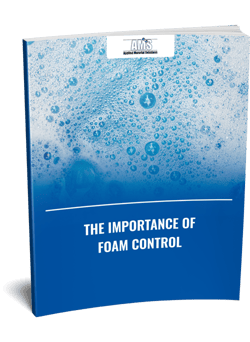A Comprehensive Guide to Executing Foam Control Solutions in Your Workflow
Efficient foam control is a critical aspect of functional effectiveness that typically goes neglected. Understanding the intricacies of foam generation can considerably influence both efficiency and product high quality. By checking out vital variables such as application compatibility and personnel training, companies can maximize their foam administration efforts.
Recognizing Foam Challenges
Foam challenges are a considerable worry throughout numerous industries, affecting operational efficiency and product top quality. The formation of too much foam can prevent procedures such as blending, transport, and storage, causing enhanced downtime and waste. In markets like food and drink, pharmaceuticals, and petrochemicals, foam can interfere with assembly line, creating item incongruities and contamination risks.
Moreover, foam can block tools performance, resulting in costly fixings and maintenance. In wastewater treatment, foam can interrupt clarifier procedures, resulting in lower treatment performance and regulatory compliance problems.
Understanding the underlying reasons for foam generation is vital for effective management. Factors such as surfactants, temperature fluctuations, and frustration degrees can all add to foam production. Identifying these components enables industries to apply targeted strategies that minimize foam formation while preserving product stability.
Kinds Of Foam Control Solutions

Mechanical solutions entail the usage of devices such as foam skimmers or defoamers. Chemical solutions, on the various other hand, include the application of defoaming agents-- compounds that interrupt the foam structure, leading to its collapse. Foam Control.
Last but not least, functional methods concentrate on process modifications. This might involve customizing tools specifications, such as temperature level and pressure, or transforming the circulation prices of liquids to decrease foam generation. Carrying out great housekeeping practices can likewise mitigate foam formation by decreasing impurities that add to foam stability.
Selecting the proper foam control solution includes evaluating the details demands of the procedure, consisting of the kind of process, the characteristics of the materials entailed, and security factors to consider.
Choosing the Right Products
Choosing the best foam control products requires a complete understanding of the certain application and its one-of-a-kind obstacles. Aspects such as the sort of foam, the environment in which it takes place, and the desired end result all play crucial duties in item selection. Foam Control. In markets like food processing, it is critical to select food-grade defoamers that comply with security guidelines while successfully handling foam.
Furthermore, think about the viscosity of the fluid where the foam issue exists. Some products are formulated for low-viscosity applications, while others are tailored for thicker liquids. Compatibility with existing processes is an additional crucial facet; the selected foam control agents need to incorporate seamlessly without interrupting general operations.
One more critical factor is the technique of application. Some items might need dilution, while others can be used directly. Analyzing the ease of usage and the needed dose can offer understandings right into the product's effectiveness and cost-effectiveness.
Application Methods
Successful application approaches for foam control options require a methodical technique that straightens Read More Here item selection with functional needs. The initial step involves a complete analysis of the processes where foam occurs, identifying certain locations that require treatment. By involving cross-functional groups, including quality, production, and design assurance, organizations can gather insights that inform the selection of one of the most effective foam control items.
Next, it is vital to develop clear purposes for foam reduction, guaranteeing that these objectives are attainable and more tips here measurable. This might involve specifying acceptable foam levels and the timelines for application. Training employees on the homes and application methods of picked foam control agents is just as essential, as appropriate usage is vital for optimum outcomes.
Furthermore, integrating foam control remedies into existing operations needs mindful planning. Ultimately, a well-structured method will certainly enhance operational efficiency while successfully taking care of foam-related challenges.
Monitoring and Assessing Efficiency
Monitoring and evaluating the performance of foam control solutions is dig this vital for making sure that applied techniques produce the desired results. This procedure involves systematic data collection and analysis to analyze the efficiency of foam control representatives and strategies. Key efficiency signs (KPIs) must be developed before implementation, permitting a clear baseline versus which to gauge progress.

Evaluating effectiveness also requires periodic reviews of foam control procedures and agent efficacy. This can be accomplished through tasting and screening, allowing operators to identify if current services are fulfilling functional demands. It is important to solicit feedback from team participants that communicate with these systems daily, as their insights can disclose functional nuances that measurable information might ignore.

Eventually, a structured tracking and assessment framework helps identify necessary adjustments, making certain that foam control options remain efficient, cost-efficient, and lined up with organizational goals.
Verdict
In verdict, efficient foam control remedies are vital for optimizing functional efficiency and maintaining item top quality. A detailed understanding of foam challenges, integrated with the choice of suitable items and application methods, helps with the successful monitoring of foam generation.
Carrying out good housekeeping practices can additionally alleviate foam formation by lowering contaminants that add to foam stability.
Picking the right foam control items requires a thorough understanding of the details application and its special challenges (Foam Control).Successful implementation strategies for foam control options require a methodical method that lines up item option with operational demands.In conclusion, reliable foam control options are vital for enhancing operational performance and keeping item quality. A complete understanding of foam obstacles, incorporated with the selection of appropriate items and execution methods, facilitates the successful management of foam generation